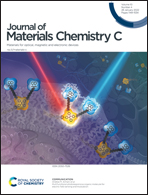Enhancement in room temperature ammonia sensing properties of naphthalene diimides through core expansion†
Abstract
An amperometric type sensor whose active layer is derived from a tetra core-substituted organic semiconductor, naphthalene diimide (NDI-CN4), has been evaluated for ammonia gas (3, 6, 25 and 50 ppm) sensing at room temperature against the parent NDI devoid of core-substitution effects. In empirical terms, the tetracyano derived sensor showed high sensitivity (178% at 50 ppm NH3) and selectivity, quick response and recovery (12.5 s/39 s), low limit of detection (3 ppm), and importantly, excellent recyclability and stability. Density functional theory and cyclic voltammetry studies indicate that the incorporation of strong electron-withdrawing groups, i.e. cyano groups, causes a substantial decrease in the reduction potential of the NDI-CN4 leading to a significant rise in the current of the sensor, mainly due to an efficient charge-transfer between NDI-CN4 and ammonia. Furthermore, because of the low-lying LUMO energy level, the NDI-CN4-based sensor shows high stability even with prolonged exposure to ambient air. A comparison with the corresponding core-unsubstituted NDI derivative confirms the positive cooperative effect of core-cyanation on gas sensing performance. It is anticipated that this work could give some useful information for preparing high performance organic sensing devices.



 Please wait while we load your content...
Please wait while we load your content...